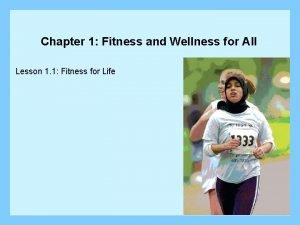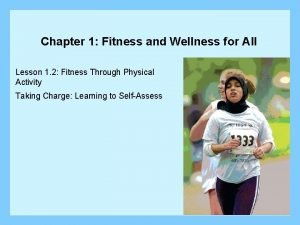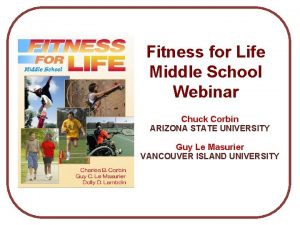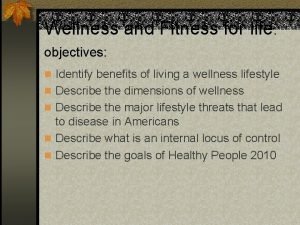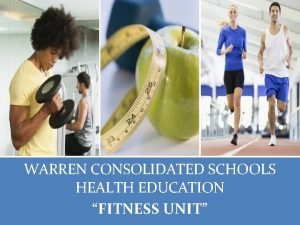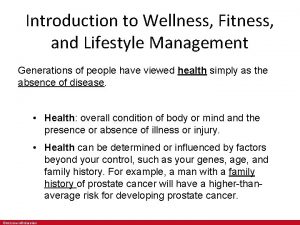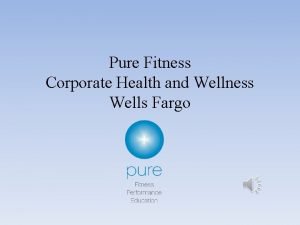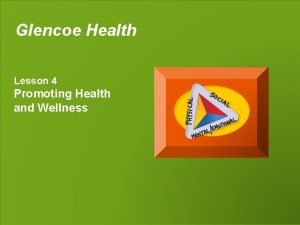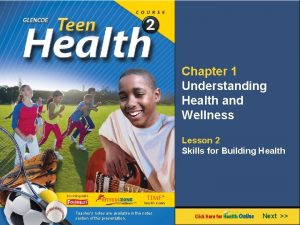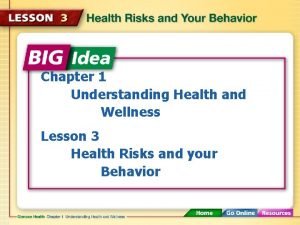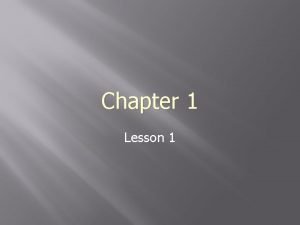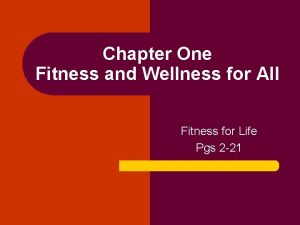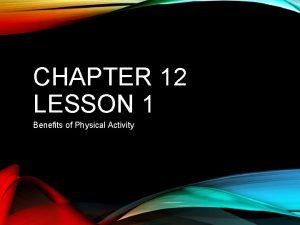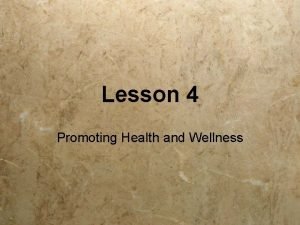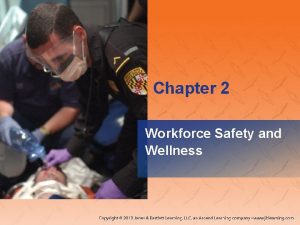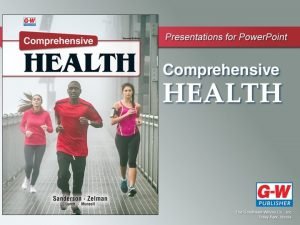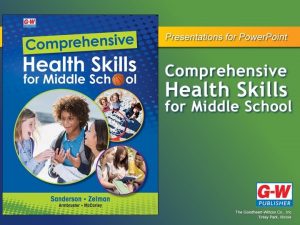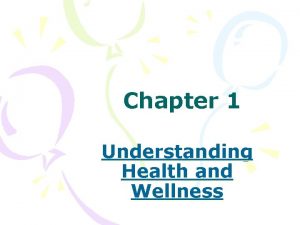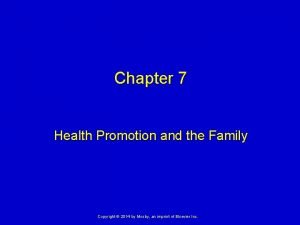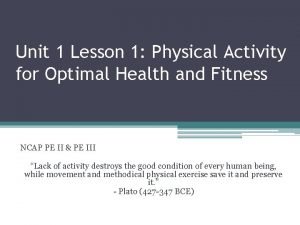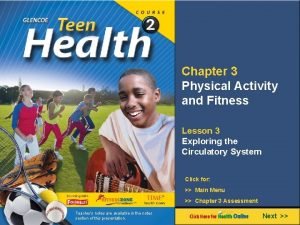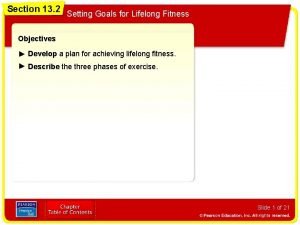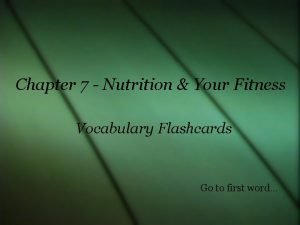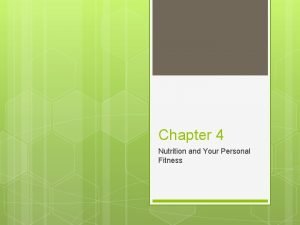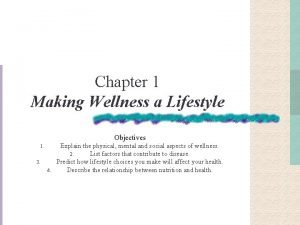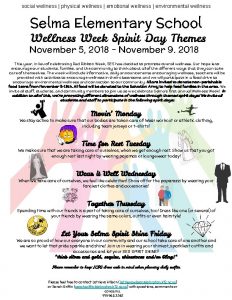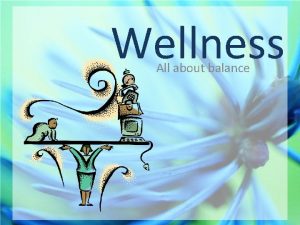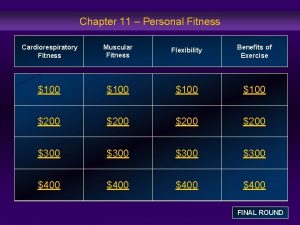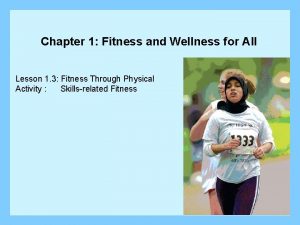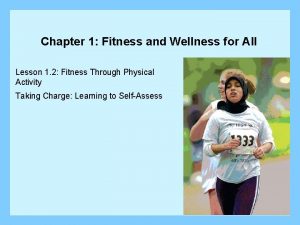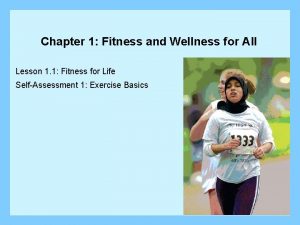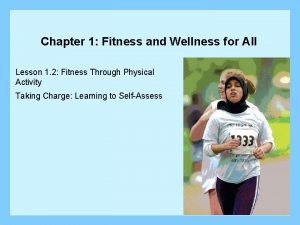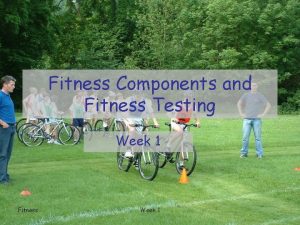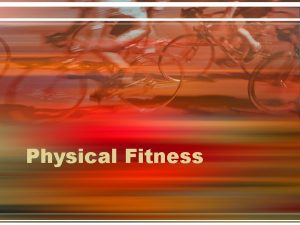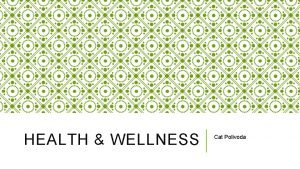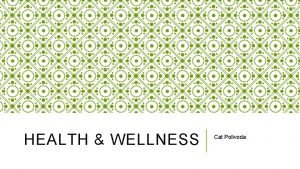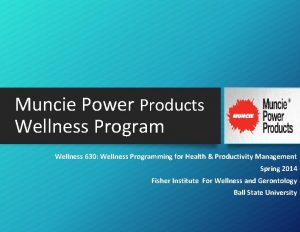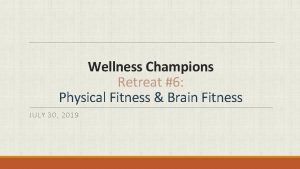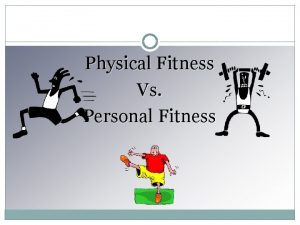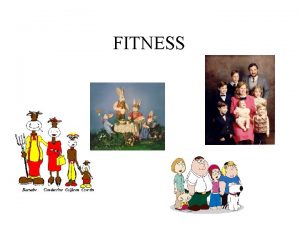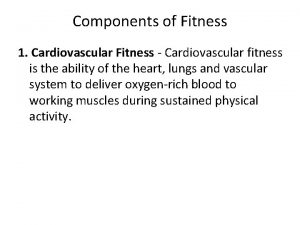Chapter 1 Fitness and Wellness for All Lesson







































- Slides: 39

Chapter 1: Fitness and Wellness for All Lesson 1. 1: Fitness for Life

Lesson 1. 1: Fitness for Life Lesson Objectives: • Define physical fitness, wellness, physical activity and exercise. • Describe some of the benefits of fitness, wellness, and physical activity. • Describe ways people can increase the amount of physical activity they may get in a day?

Lesson 1. 1: Fitness for Life Question What is meant by the term physical fitness?

Lesson 1. 1: Fitness for Life Answer Physical fitness is the ability of the body systems to work together efficiently to enhance health and improve performance in our daily lives.

Lesson 1. 1: Fitness for Life Some of the systems that work together are • muscles, • heart and cardiovascular system, • respiratory system, • skeletal system, and • nervous system.

Lesson 1. 1: Fitness for Life Question Why is it important for people to be physically fit?

Lesson 1. 1: Fitness for Life Answer Physical fitness can • lower the risk of diseases, • improve the quality of life, • lower the risk of injury, • improve sport performance, • improve work efficiency, and • help you have energy to enjoy leisure.

Lesson 1. 1: Fitness for Life Question What does the term wellness mean?

Lesson 1. 1: Fitness for Life • Define Wellness: Wellness is a state of being that enables you to reach your fullest potential. • It includes the following areas of our lives: Intellectual (being well informed), Social (being involved), Emotional (being happy) , Physical (being physically fit) and Spiritual (being fulfilled) • Wellness is the positive component of good health. • Wellness is having a good quality of life & a sense of well -being.

Lesson 1. 1: Fitness for Life Question What is meant by the term physical activity?

Lesson 1. 1: Fitness for Life • Physical Activity is movement of the large muscles of the body. • P. A. includes sports, dance, and activities done at home or work such as walking, climbing stairs, or mowing the lawn. Most people become less physically active as they grow older. • The Surgeon General’s report on Physical Activity and Health indicates that Physical inactivity is a major risk factor for many Hypokinetic diseases.

Lesson 1. 1: Fitness for Life • Define Exercise

Lesson 1. 1: Fitness for Life • Exercise is physical activity done for the purpose of getting fit and is a scheduled period of time. •

Lesson 1. 1: Fitness for Life • Good Health and Wellness helps us to be more physically active. • This cycle is called the Cycle of Physical Activity. • The top box is PHYSICAL ACTIVITY ……. which leads to PHYSICAL FITNESS …. . …which leads to WELLNESS ……. . which leads back to Physical Activity.

Lesson 1. 1: Fitness for Life Question What are the health benefits from being physically active and physically fit?

Lesson 1. 1: Fitness for Life People who are physically fit have • LOWER RISK of HYPOKINETIC DISEASES…. . (cardiovascular diseases, Type II diabetes, osteoporosis, obesity). • LOWER RISK of BACK PROBLEMS. • Fit people can also: COPE WELL WITH STRESS… or emergency situations. • less likelihood of smoking cigarettes. • participate in sports and outdoor recreational activities. • function better as they grow older • Lead physically active and happy lives

Lesson 1. 1: Fitness for Life Question How can a person increase the amount of physical activity he/she may get in a day?

Lesson 1. 1: Fitness for Life Answer A person increases the amount of physical activity he/she may get in a day by • planning scheduled exercise sessions, • Walk or ride a bike to work • do daily lifestyle activity (yard work, gardening).

• End lecture 1. 1

• blank

Lesson 1. 1: Fitness for Life Question What lifestyles lead to good health and wellness?

Lesson 1. 1: Fitness for Life If you are healthy • you are free from illnesses, • you have good wellness, • you have good physical fitness, and • you have other indications of health that a doctor can measure, such as healthy blood pressure and cholesterol levels. • Early definitions concentrated on illness; now they include wellness.

Lesson 1. 1: Fitness for Life Answer Lifestyles that lead to good health include • being physically active on a regular basis, • eating well, • coping with stress, • using good personal health practices, and • avoiding destructive habits.

Lesson 1. 1: Fitness for Life Question What types of jobs and careers do not require much physical activity?

Lesson 1. 1: Fitness for Life Answer Careers in • outdoor recreation, • trades such as building, roofing, or gardening, • military, police work, fire department, and • professional sports.

Lesson 1. 1: Fitness for Life Question What types of jobs and careers feature a high physical activity component?

Lesson 1. 1: Fitness for Life Answer Careers in • office work, • computer jobs, • hair styling, • dentistry, • library science, • some types of teaching, and • other white-collar jobs.

Lesson 1. 1: Fitness for Life Question How can we tell who the most physically active people in this class might be?

Lesson 1. 1: Fitness for Life Answer The most physically active people in this class probably • do many in-school activities: – physical education – sports teams – intramurals • do many out-of-school activities: – community sports – active work – lifestyle or recreational activity

Lesson 1. 1: Fitness for Life Question What are other benefits of being physically active and physically fit?

Lesson 1. 1: Fitness for Life Answer Fit people can • cope well with stressful or emergency situations, • participate in sports and outdoor recreational activities, • function better as they grow older, and • lead physically active and happy lives.

Self-Assessment 1: Exercise Basics There are two objectives: • to learn how to do warm-up and cool-down exercises, and • to learn how to count heart rate. Consult your workbook and follow the guidelines for self-assessment in this chapter.

Self-Assessment 1: Exercise Basics Question Describe the five warm-up exercises. What is the purpose of each?

Self-Assessment 1: Exercise Basics Answer Some warm-up exercises are • heart warm-up (jogging, walking), • side stretch (abdominal, side muscles), • knee-to-chest stretch (low back, buttocks), • back and hip stretch (back and hip), and • two-leg calf stretch (calf). (See text for photos, pages 7 -9. )

Self-Assessment 1: Exercise Basics Question Describe the two methods of counting heart rate (pulse). What are some good rules to follow for counting resting heart rate?

Self-Assessment 1: Exercise Basics Answer The two methods of counting heart rate (pulse) are: 1. carotid (neck pulse) 2. radial (wrist pulse)

Self-Assessment 1: Exercise Basics Answer Some good rules to follow for counting resting heart rate are • count early in morning, and • determine one-minute resting rate, using • 15 sec x 4, 10 sec x 6, 6 sec x 10.

Self-Assessment 1: Exercise Basics Question What are some good rules to follow for counting exercise heart rate?

Self-Assessment 1: Exercise Basics Answer Some good rules to follow for counting exercise heart rate are • locate pulse quickly, • do typical exercise before count, and • choose a short count (e. g. , 15 sec x 4) because long counts allow heart rate to slow down.
 Fitness chap 1
Fitness chap 1 Fitness chapter 1
Fitness chapter 1 Stairway to lifetime fitness health and wellness
Stairway to lifetime fitness health and wellness Objectives of fitness and wellness
Objectives of fitness and wellness Stairway to lifetime fitness health and wellness
Stairway to lifetime fitness health and wellness Introduction to wellness fitness and lifestyle management
Introduction to wellness fitness and lifestyle management Wells fargo wellness program
Wells fargo wellness program Chapter 1 lesson 4 promoting health and wellness
Chapter 1 lesson 4 promoting health and wellness Chapter 1 lesson 4 promoting health and wellness
Chapter 1 lesson 4 promoting health and wellness Chapter 1 lesson 2 what affects your health
Chapter 1 lesson 2 what affects your health Chapter 1 lesson 2 what affects your health
Chapter 1 lesson 2 what affects your health Chapter 1 understanding health and wellness lesson 3
Chapter 1 understanding health and wellness lesson 3 Chapter 1 lesson 4 promoting health and wellness
Chapter 1 lesson 4 promoting health and wellness Health vs skill related fitness
Health vs skill related fitness Fitness vs wellness
Fitness vs wellness Chapter 12 lesson 4 fitness safety and avoiding injuries
Chapter 12 lesson 4 fitness safety and avoiding injuries Chapter 12 physical activity and fitness answer key
Chapter 12 physical activity and fitness answer key Lesson 4 promoting health and wellness
Lesson 4 promoting health and wellness Name a line containing point a
Name a line containing point a Understanding your health and wellness chapter 1
Understanding your health and wellness chapter 1 Workforce safety and wellness chapter 2
Workforce safety and wellness chapter 2 The ability to locate interpret and apply information
The ability to locate interpret and apply information Chapter 1 understanding your health and wellness
Chapter 1 understanding your health and wellness Chapter 1 understanding your health and wellness
Chapter 1 understanding your health and wellness Chapter 1 understanding your health and wellness
Chapter 1 understanding your health and wellness Chapter 7 promoting health and wellness
Chapter 7 promoting health and wellness Chapter 3 health wellness and health disparities
Chapter 3 health wellness and health disparities Unit 1 lesson 1 the importance of fitness
Unit 1 lesson 1 the importance of fitness Fitness chapter 3
Fitness chapter 3 Lesson 3 components of fitness
Lesson 3 components of fitness Lifelong fitness formula
Lifelong fitness formula Chapter 7 nutrition and your fitness
Chapter 7 nutrition and your fitness Fitness chapter 7
Fitness chapter 7 Chapter 4 nutrition and your personal fitness
Chapter 4 nutrition and your personal fitness Fitness chapter 12
Fitness chapter 12 Seven fitness nutrition
Seven fitness nutrition Chapter 3 water and the fitness of the environment
Chapter 3 water and the fitness of the environment Making wellness a lifestyle
Making wellness a lifestyle Kontinuitetshantering i praktiken
Kontinuitetshantering i praktiken Typiska novell drag
Typiska novell drag
